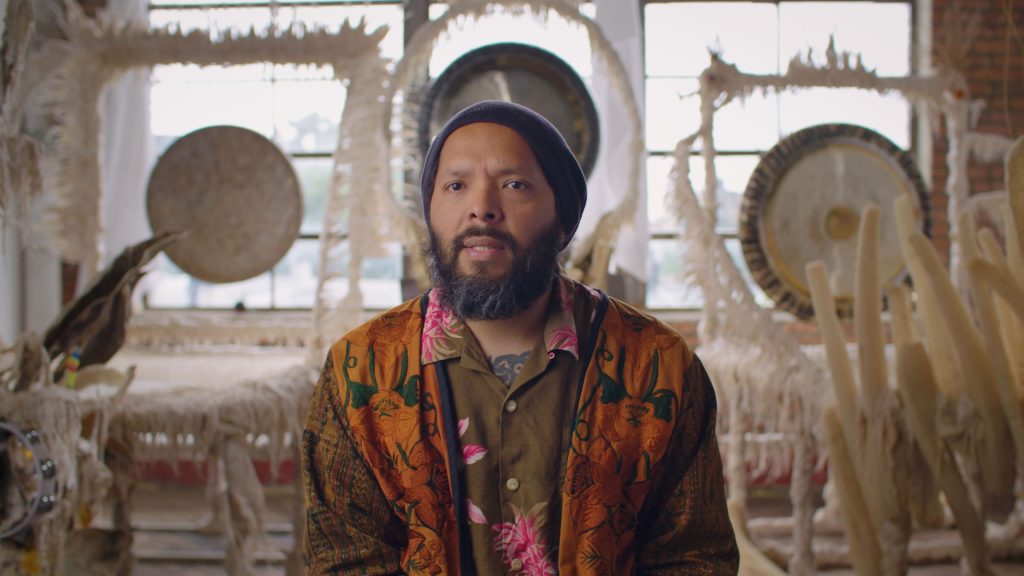Art World
‘This Healing Ritual Can Continue’: Watch Artist Guadalupe Maravilla Confront Communal Trauma Through Experiential Art
As part of a collaboration with Art21, hear news-making artists describe their inspirations in their own words.

As part of a collaboration with Art21, hear news-making artists describe their inspirations in their own words.

Caroline Goldstein

At 44, artist Guadalupe Marvilla’s life story is almost unbelievable. A grand bildungsroman that begins with him “playing on the steps of the pyramids in El Salvador,” fleeing a war, embarking on a two-and-a-half month journey from his home in San Salvador to Honduras, Guatemala, Mexico, and then crossing the border to the U.S. illegally and alone at the age of eight. In his late 30s he overcame colon cancer and went on to use his incredible life experience to heal others through art.
Now, at Socrates Sculpture Park in New York, an enlightening experiential show of work by Maravilla is on view, touching on themes of migration, identity, trauma, knowledge, and healing. Its title, “Planeta Abuelx,” riffs on the notion of Mother Earth, expanding it to encompass multigenerational and gender-neutral people, while paying homage to the elders whose knowledge forms the basis of cultural heritage, and yet are often not valued in contemporary society.
In an exclusive interview with Art21 as part of its Extended Play series, Maravilla appears installing his multimedia works at Socrates, which include sculptures, botanical installations, and sound baths.

Production still from the Art21 “New York Close Up” film, “Guadalupe Maravilla & the Sound of Healing.” © Art21, Inc. 2021.
Discussing his childhood, Maravilla explains the significance of Mayan architecture and rituals. “Especially the sculptures—those sculptures, they were these giant steles carved out of a rock—and how they told stories. But they’re also objects to perform rituals in,” he tells Art21. For the artist, this sparked an idea that would become his “Disease Thrower” series, made of sculptural objects that can be used as “headdresses, shrines” and “healing instruments.” Taking the form of totemic sculptures, the works are made from materials the artist collected from places he traversed on his border crossing.
The hulking aluminum sculptures are situated at the tip of a circle, inside of which he has drawn the lines of his migratory path, alluding to a childhood game called “Tripa Chuca,” where players begin drawing lines at the same time, without crossing paths. The game has become a collaborative work, where the artist invites others to trace their own journeys, spiritual or physical, to create unique, but ephemeral patterns.

Production still from the Art21 “New York Close Up” film, “Guadalupe Maravilla & the Sound of Healing.” © Art21, Inc. 2021.
A major component of Maravilla’s practice is creating sound baths, which he first encountered to offset the detrimental effects of radiation therapy for his cancer. The artist believes that his cancer was a manifestation of his childhood trauma, and he now practices healing rituals for undocumented immigrants and visitors to his installations.
“Having a community that has gone through similar experiences can be really empowering,” he tells Art21. And although his work is rooted in autobiography, “making these elaborate ‘Disease Throwers’ is not just about telling a story from my past, but it’s also about how this healing ritual can continue in the future, long after I’m gone.”
Watch the video, which originally appeared as part of Art21’s Extended Play series, below. “Guadalupe Maravilla: Planeta Abuelx” is on view at Socrates Sculpture Park through September 6, 2021, and two more sound baths (featured in the film) will take place at the park on August 14 and September 4.
This is an installment of “Art on Video,” a collaboration between Artnet News and Art21 that brings you clips of newsmaking artists. A new series of the nonprofit Art21’s flagship series Art in the Twenty-First Century is available now on PBS. Catch all episodes of other series like New York Close Up and Extended Play and learn about the organization’s educational programs at Art21.org